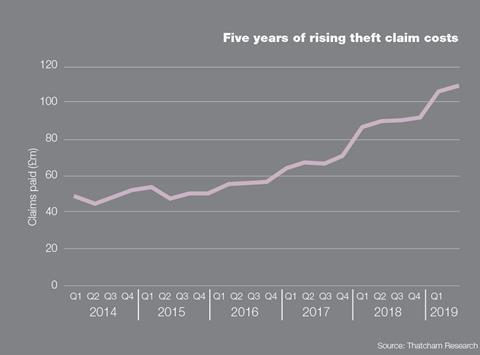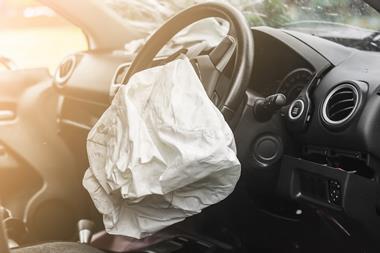Statistics from ABI indicate that after five consecutive quarters of year-on-year decreases in average premiums, it looks like motor insurance rates are on the up
Reinsurance rate increases, a surprise discount rate change and claims inflation are conspiring to drive up the cost of motor insurance.
The latest statistics released by the ABI Motor Insurance Premium Tracker show that after five consecutive quarters of year-on-year decreases in average premiums, motor insurance rates in the second and third quarters of 2019 have flattened out.
The average price paid for motor insurance is currently £468 and there is anticipation that rates will rise.
There are several reasons for the stalling in the direction of rates, but the two main drivers are the Ogden discount rate revision and claims inflation, caused by rising repair costs. The change to Ogden fell short of industry expectations in July when it was revised from -0.75% to -0.25%.
It is expected to lead to reserve strengthening for reinsurers and insurers that had anticipated the rate would be set between 0% and 1%; PwC estimates this could lead to the average motor insurance premium increasing by between £15 and £25, going up by as much as £50 to £75 for younger drivers.
Ogden rate revisions
There is also anticipation of significant motor reinsurance rate corrections at the upcoming 1 January renewals, which will have an impact on insurance pricing.
“The Ogden rate revision went against market expectations and that will force prices up, not only in the immediate term,” said Gary Humphreys, group underwriting director at Markerstudy.
“The expectation is that the excess of loss reinsurance rates will increase in the region of 20% at 1 January 2020. This will drive up the cost of motor insurance.
“With Ogden, the industry had expected 0% as a worst-case scenario and were hopeful of a positive half percent rate going forward,” he added. “That it remained negative caught the reinsurance market out to a degree, as it was so unexpected. In most cases, they’ve taken another hit to their reserves.”
Meanwhile, the Scottish personal injury discount rate has remained unchanged at -0.75%, as of the end of September. According to Alastair Ross, assistant director, head of public policy for Scotland, Wales and NI at the ABI, the outcome “means that compensators, including the NHS, public bodies and insurers, will face higher payouts in Scotland.”
He added: “A discount rate that’s lower for Scotland than England and Wales will mean higher insurance costs north of the border, which could push up premiums for Scottish motorists as a result.”
Another factor is the ongoing performance review at Lloyd’s and elsewhere in the industry. This has had an impact on reinsurance capacity, driving up the price of wholesale risk transfer for UK motor insurers.
The Decile 10 initiative, spearheaded by Lloyd’s performance management director Jon Hancock, targeted the least profitable 10% of business in the market. Over the past 12-18 months some syndicates, including MS Amlin and XL Catlin, have withdrawn from UK motor classes of business. According to Stackhouse Poland, the exits come after a period of challenging operating conditions, with abundant capacity causing falling or sustained low premiums.
“In certain sectors, underwriters are making significant losses. To correct this position we are seeing many insurers exit unprofitable and non-core underwriting areas,” it said in a briefing note.
Rising cost of repairs
An increase in claims severity is another reason why motor insurance premiums are expected to continue their upward pricing momentum in 2020.
The growing complexity of vehicles, with expensive and high-tech parts, is driving up repair costs and contributing to claims inflation.
Kulbir Kang, claims director at Marsh Commercial, said: “Although technology advancement in vehicles, such as the use of modern materials and new sensor technology, is helping to reduce the frequency of incidents, it is also resulting in rising repair costs.
“An increased uptake of electric vehicles is also making the repair process more complex. Insurers’ reserves are on an upward trend, evidencing ongoing increasing fleet claims costs.”
The cost of parts in insurance-related repairs has risen by 40% over the past five years, according to research by Trend Tracker. Overall repair costs have grown by one third over the past four years, according to the ABI, which identifies advanced driver assistance systems (ADAS) as one of the causes.
More than 10% of vehicles on the road today are fitted with autonomous emergency braking (AEB), equating to some four million cars, according to Thatcham Research. While such features should reduce the frequency of claims, incidents can be more expensive to rectify when they do occur. The positioning and functionality of some of the more high-tech parts being introduced means they are often more susceptible to damage.
“Some of these features are not repairable, even if only slightly damaged, such as certain headlamps,” said Graeme Trudgill, executive director of Biba. “This could push up claims inflation.
“Such parts are often more expensive than conventional parts and if they cannot be replaced the claim cost might be even higher,” he added. “Additionally, specialist part replacement may take longer, possibly resulting in increased third party credit hire costs.”
As vehicles become more sophisticated, Thatcham is calling for an ADAS Code of Practice to ensure repair standards keep up with changing requirements.
Richard Billyeald, chief technical officer at Thatcham, said: “ADAS supports the driver to prevent a crash in the first place. This represents a huge step forwards for vehicle safety.
“However, while that benefit may be fully realised on a new car, maintaining it once a car has been repaired is vital,” he added. “The whole industry needs to work together to make sure ADAS repairs are safe and vehicles are returned to the road, quickly and efficiently.”
Sticky fingers
Connected to ADAS trends is the vulnerability inherent in keyless cars, a factor that is contributing to a growing frequency of theft claims. In the first half of the year, the cost of theft rose by 18% on the same period last year to £211m.
This is likely to reach its highest level in a decade by year end, according to the ABI. Rising theft claims are likely to further influence motor insurance premiums if last year’s total car theft payout of £376m is surpassed in 2019.
In March, Thatcham published new security ratings taking into account the vulnerability of vehicles to keyless relay attack. It gave six of the 11 vehicles launched this year a ‘poor’ rating as there are no security measures attached to the keyless entry/start system.
What is relay theft?

Relay theft exploits a vulnerability in passive keyless entry systems, which allow drivers to open and start their cars without removing the keyless fob from their pocket. Usually operating in pairs, one criminal holds a device up against the front wall or porch of a home, searching for a signal from the keyless fob. The device relays the key’s signal to an accomplice, who is holding another device against the car door.
The car is effectively fooled into believing that the owner is within a defined range (usually 2m) and is approaching the car with their key. The door opens, and the signal is relayed to the accomplice a second time, allowing the car to start. Once started the engine will not restart without the key present.












































No comments yet